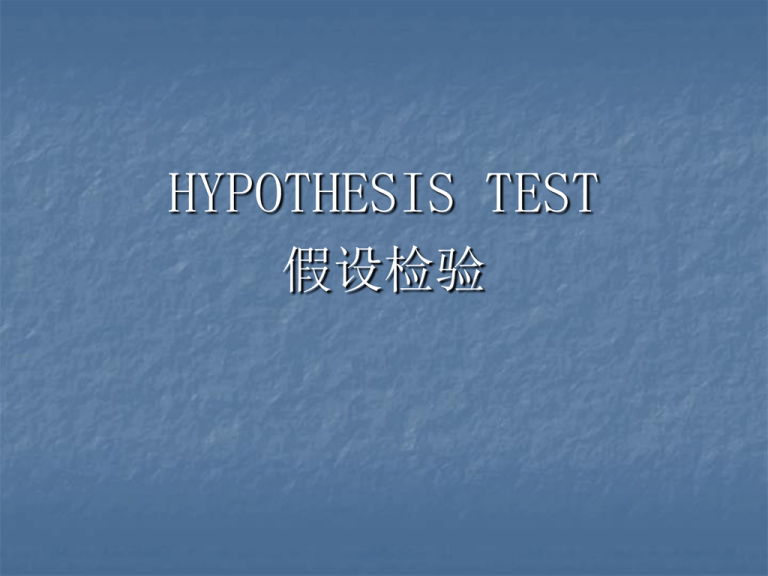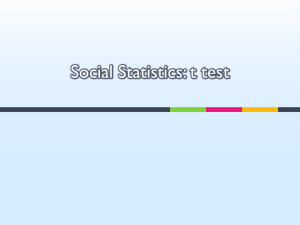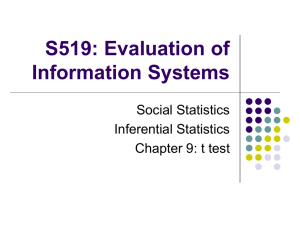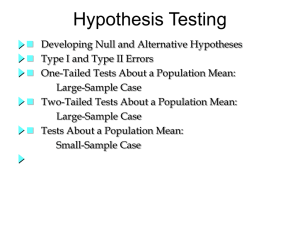Chapter 9 第九章
advertisement

HYPOTHESIS TEST 假设检验 Instruction In this chapter you will learn how to formulate hypotheses about a population mean and a population proportion. Through the analysis of sample data, you will be able to determine whether a hypothesis should or should not be rejected. 9.1 DEVELOPING NULL AND ALTERNATIVE HYPOTHESIS In some application it may not be obvious how the null and alternative hypothesis should be formulated. We must be careful to make them properly. There will be three types of situations in which hypothesis testing procedures are commonly employed. Testing Research Hypothesis There is an automobile model example on page 325 to illustrate the testing research hypothesis. Testing the validity of a claim there is a soft drinks example on the page 325 to illustrate the testing the validity of a claim. Testing in decision-making situation There is an example of shipment on the page 326 to illustrate the testing in decision-making situation. Summary of Forms for Null and Alternative Hypotheses H μ≥µ H µ <µ 0: 0 a: 0 H µ ≤µ H µ >µ 0: 0 a: 0 Hµ Hµ 0: a: µ ≠µ = 0 0 9.2 type I and type II errors population condition ----------------------------H0 True Ha True Accept H0 Correct Conclusion Type II Error Reject H0 Type I Error Correct Conclusion Instructions If the sample data are consistent with the null hypothesis H0, we will follow the practice of concluding “do not reject H0.” This conclusion is preferred over “accept H0.” because the conclusion to accept H0 puts us at risk of making a Type II error. 9.3 One-tailed test about a population mean: large-sample case There is a Hilltop Coffee example to illustrate the one-tailed test about population mean on page 330. The null and alternative hypotheses are as follows: H0:µ≥3 Ha:µ<3 The test statistic In the large-sample case with the population standard deviation σassumed known, the test statistic is given by 公式: x 0 z / n Summary large-sample (n≥30) hypothesis test about a population mean for a one-tailed test of the form H0:µ≥µ0 Ha:µ< µ0 Test Statistic:σ known x 0 z / n Test statistic:σEstimated by s x 0 z s/ n Rejection Rule Using test statistic: Reject H0 if z<-zα Using p-value: Reject H0 if p-value<α Steps of Hypothesis Testing Steps of Hypothesis Testing 1. Develop the null and alternative hypotheses. 2. Specify the level of significance α. 3. Select the statistic that will be used to test the hypothesis. Using the test statistic 4. Use the level of significance to determine the critical value for the test statistic and state the rejection rule for H0. 5. Collect the sample data and compute the value of the test statistic. 6. Use the value of the test statistic and the rejection rule to determine whether to reject H0. Using the p-value 4. Collect the sample data and compute the value of the test statistic. 5. Use the value of the test statistic to compute the p-value. 6. Reject H0 if p-value<α 9.4 Two-tailed test about a population mean: large-sample case Two-tailed tests differ from one-tailed hypothesis tests in that two-tailed tests have rejection regions in both the lower and upper tails of the sampling distribution. example There is an example of golf balls mean distance at page 339. The null and alternative hypotheses are as follows: H0 :μ=280 Ha :μ≠280 The test statistic With a sample size of 36 golf balls used each time the quality control test is performed, we have a large-sample case. As s result the test statistic is x 0 z / n Summary: Two-tailed tests about a population mean Large-sample (n≥30) hypothesis test about a population mean for a two-tailed test of the form H0:μ=μ0 Ha:μ≠μ0 Test statistic:σassumed known x 0 z / n Test statistic:σ estimated by s x 0 z s/ n Rejection rule Using test statistic: Reject H0 if z<-zα/2 or if z>zα/2 Using p-value: Reject H0 if pvalue<α Relationship between interval estimation and hypothesis testing The details about the differences between these two approaches are at page 342-343. A confidence interval approach to testing a hypothesis of the form H0:μ=μ0 Ha:μ≠μ0 1.Select a simple random sample from the population and use the value of the sample mean x to develop the confidence interval for the population mean μ. If σis assumed known, compute the interval estimate by using xz 2 n If σis estimated by s, compute the interval estimate by using xz 2 s n 2. If the confidence interval contains the hypothesized value μ0, do not reject H0. otherwise, reject H0. 9.5 Test about a population mean: small-sample case The procedures for hypothesis test about a population mean discussed in section 9.3 and 9.4 were based on the central limit theorem and large-sample theory. In section 9.5, we consider tests about a population mean using a small sample (n<30). Assumption The small-sample case require the assumption that the population has a normal probability distribution. If this assumption is not appropriate, the best alternative is to increase the sample size to n≥30 and rely on the largesample hypothesis testing procedures. Test statistic If the population standard deviation σ is assumed known: z x 0 n If the population standard deviation σis estimated by the sample standard deviation s: x t s n 0 There is an example of the international air transport association on page 348. p-values and the t distribution is on page 348-349. Two-tailed test is similar to one-tailed test. It is on the page 349-350. 9.6 Test about a population proportion Three forms for a hypothesis test about a population proportion are as follows: H0:p≥p0 H0:p≤p0 H0:p=p0 Ha :p<p0 Ha :p>p0 Ha:p≠p0 The first two forms are one-tailed tests, and the third form is two-tailed test. If both np and n(1-p) are greater than or equal to 5. The sampling p distribution of can be approximated by a normal probability distribution , the following test statistic can be used. Test statistic for test about a population proportion: z where p p0 p p0 (1 p0 ) p n 9.7 hypothesis testing and decision making There is an example of shipment of batteries on page 360. When we do not reject H0, action we take may risk Type ІІ error . In section 9.8 and 9.9 we explain how to compute the probability of making a Type ІІ error and how the sample size can be adjusted to help control the probability of making a Type ІІ error. 9.8 calculating the probability of type ІІ errors There is an example on page 360-362. suppose α=.05 and a mean life of µ=112 hours. probability of a Type ІІ error when µ=112 β=.0091 112 116.71 Accept H0 There is a table to show the probability of making a Type ІІ error for a variety of values of µ less than 120. Note that as µ increases toward 120, the probability of making a Type ІІ error increases toward an upper bound of .95. value of µ 公式 112 114 115 116.17 117 118 119.999 2.36 1.36 .86 .00 -.15 -.65 -.1.645 p ability of a Type ІІ error(β) .0091 .0869 .1949 .5000 .5596 .7422 .9500 power (1-β) .9909 .9131 .8051 .5000 .4404 .2578 .0500 Power curve for the lot-acceptance hypothesis test 1.00 .80 .60 .40 .20 112 115 118 120 summary Procedure to compute the probability of making a Type ІІ error: 1. Formulate the null and alternative hypothesis 2. Use the level of significance αto establish a rejection rule based on the test statistic. 3. Using the rejection rule, solve for the value of the sample mean that identifies the rejection region for the test. 4. Use the results from step3 to state the values of the sample mean that lead to the acceptance of H0. It also defines the acceptance region for the test. 5. Using the sampling distribution of x for any value of µ from the alternative hypothesis, and the acceptance region from step4, compute the probability that the sample mean will be in the acceptance region. This probability is the probability of making a Type ІІ error at the chosen value of µ 9.9 determining the sample size for a hypothesis test about a population mean Recommended sample size for a one-tailed hypothesis test about a population mean n ( z z ) 2 (0 a ) 2 2 Where zα=z value providing an area of αin the tail of a standard normal distribution zβ=z value providing an area of βin the tail of a standard normal distribution σ=the population standard deviation µ0 =the value of the population mean in the null hypothesis µa =the value of the population mean used for the Type ІІ error








